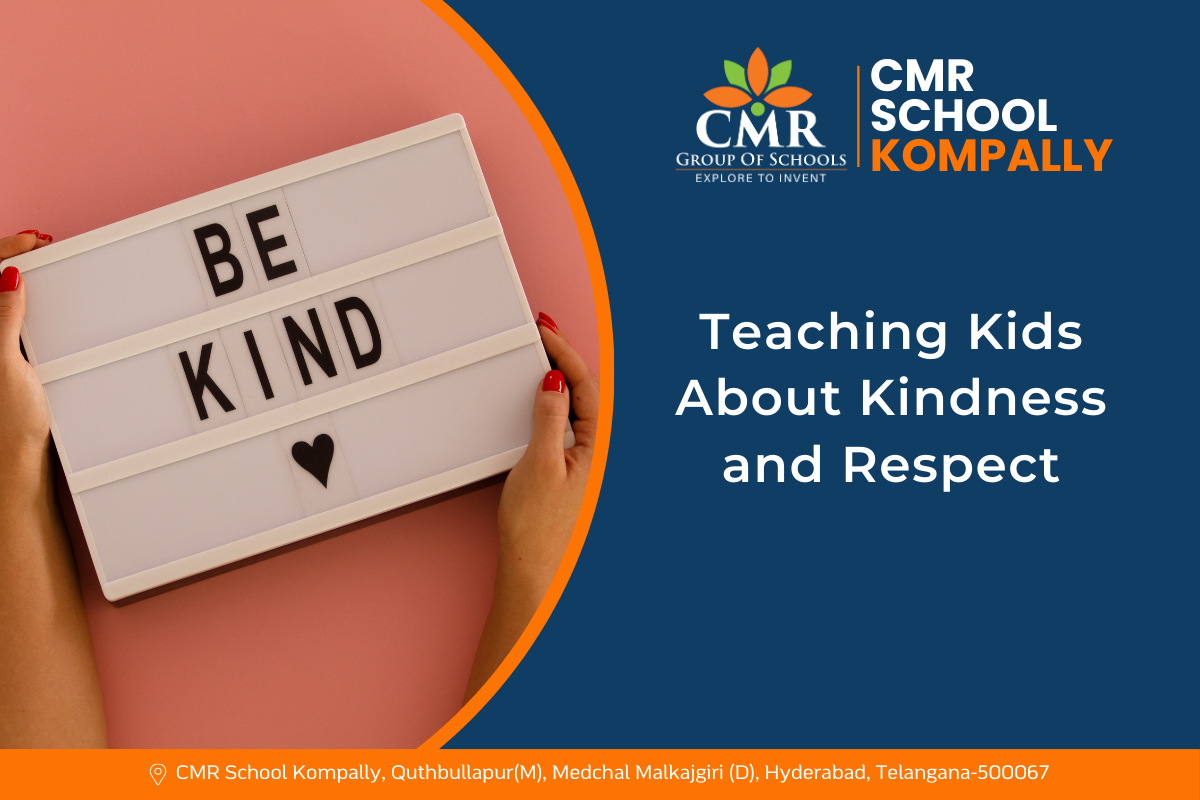We all want to raise children who are kind, respectful, and thoughtful. But with today’s fast-paced life, social media pressures, and limited face-to-face interaction, these values can sometimes get lost.
At CMR School, Kompally, we believe teaching kindness and respect isn’t just important — it’s essential. These qualities shape the way children treat others, handle disagreements, and contribute to society. It’s not just about manners — it’s about building character.
Ready to raise kind humans? Let’s begin.
1. Introduction
If you’ve ever seen a child help a friend, say “thank you” without being reminded, or stand up for someone being treated unfairly — you know how powerful kindness can be.
At CMR School, Kompally, we believe these small actions can change the world. But children don’t just “pick up” kindness — they learn it through consistent teaching and, more importantly, through example.
2. Why Kindness and Respect Matter
Kindness and respect are more than just polite behavior. They help kids:
- Build strong, healthy relationships
- Navigate peer pressure and conflict
- Develop empathy and self-awareness
- Grow into responsible citizens
Without these core values, academic success means very little.
3. Start Young: Early Lessons Begin at Home
The earlier you start, the easier it sticks.
Even toddlers can learn:
- To share toys
- To say “please” and “thank you”
- That hitting or yelling hurts others
Kindness is like a muscle — the more it’s practiced, the stronger it becomes.
4. Be a Role Model for Kind Behavior
Kids are like sponges — they watch more than they listen.
Show kindness by:
- Speaking gently to others
- Helping neighbors or friends
- Treating service workers with respect
- Listening without interrupting
When kids see you living the values you preach, they learn without lectures.
5. The Power of Words: Teach Respectful Language
Language is one of the most visible ways respect is shown.
Encourage children to:
- Say “excuse me,” “please,” and “thank you”
- Avoid name-calling or teasing
- Use words to express frustration instead of shouting
Teach them: Words can hurt or heal — choose wisely.
6. Teach Through Stories and Books
Stories create safe spaces to explore emotions and values.
Recommended reads:
- Have You Filled a Bucket Today? by Carol McCloud
- The Invisible Boy by Trudy Ludwig
- Wonder by R.J. Palacio
Discuss the characters: What did they do right? What could they have done differently?
7. Set Clear Expectations and Boundaries
Children feel safe when they know what’s expected of them.
Set family or classroom rules like:
- Speak kindly, even when upset
- Help someone when you can
- Say sorry when you hurt someone
Consistency helps these values stick.
8. Encourage Empathy Through Conversations
Ask questions that make kids think about how others feel:
- “How do you think your friend felt when that happened?”
- “Would you like it if someone did that to you?”
- “What could you do to make them feel better?”
This turns daily interactions into empathy-building moments.
9. Praise Acts of Kindness
Kids love recognition — and it encourages repetition.
Instead of vague praise like “Good job,” try:
- “That was really kind of you to share your snack.”
- “I saw you comfort your friend — that shows big heart.”
Highlighting these moments shows kindness matters as much as achievement.
10. Handle Disrespect Calmly and Firmly
Kids will test limits — and that’s okay.
When they act out:
- Stay calm (even if you’re frustrated)
- Label the behavior: “That was disrespectful because…”
- Explain what should be done differently
Avoid shaming. Focus on teaching, not punishing.
11. Teach Respect for Differences
In today’s diverse world, respect must go beyond politeness.
Talk to kids about:
- Different cultures and traditions
- Varying opinions and beliefs
- Disabilities and neurodiversity
Encourage curiosity, not judgment. “Different” doesn’t mean “less.”
12. Use Real-Life Scenarios
Use what’s happening around your child to teach lessons:
- “How could we help the new student?”
- “What would you say if someone was being bullied?”
- “How can we show respect to elders in our family?”
Life is full of teachable moments.
13. Encourage Volunteering and Community Work
Involving kids in small acts of service teaches:
- Gratitude
- Compassion
- Responsibility
Ideas include:
- Visiting an elderly home
- Participating in a cleanliness drive
- Donating toys or clothes to those in need
These acts make kindness real and actionable.
14. How CMR School Encourages Kindness
At CMR School, Kompally, kindness is part of our culture.
We:
- Celebrate Kindness Week with meaningful activities
- Organize peer mentoring and buddy systems
- Teach value education as part of our curriculum
- Include mindfulness, gratitude, and empathy sessions
- Encourage student-led community service projects
We don’t just teach kindness — we live it.
15. Conclusion
Teaching kids about kindness and respect isn’t about a one-time talk. It’s a journey of showing, guiding, correcting, and celebrating.
At CMR School, Kompally, we believe every child can grow into a kind, respectful individual — not by chance, but by daily practice and positive examples.
So, next time your child helps a friend, says sorry on their own, or stands up for what’s right — pause and smile. You’re raising someone who will make the world better.
And that’s something to be proud of.
16. Frequently Asked Questions (FAQs)
1. At what age should I start teaching kindness and respect?
You can start as early as toddlerhood. Simple lessons like sharing and saying “thank you” build the foundation for lifelong values.
2. What if my child doesn’t seem naturally kind?
Kindness is a skill, not just a personality trait. With regular guidance, examples, and praise, most children learn to be caring and respectful.
3. How do I handle my child being disrespectful to others?
Stay calm, explain why the behavior is wrong, and suggest a better way to respond. Focus on correcting, not shaming.
4. Can school alone teach kindness and respect?
School plays a key role, but the most consistent learning comes from home. When school and parents work together, the message is stronger.
5. What activities help build kindness in children?
Volunteering, helping at home, journaling gratitude, role-playing, reading stories about kindness, and doing small acts of service all help develop empathy and respect.



